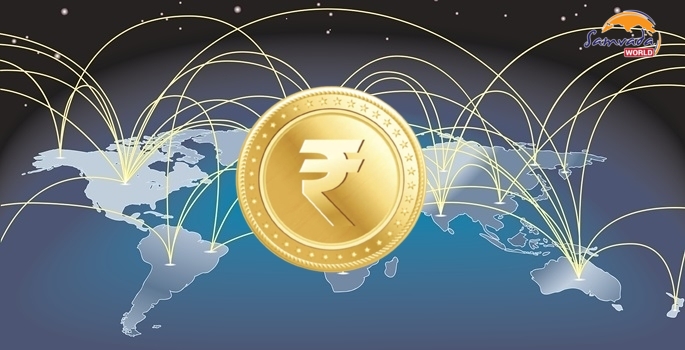
- The internationalisation of the rupee that is traded in the digital format will be a good move.
- It will not only help in trade facilitation but also increase the stature of the rupee in the international market.
- Digital Rupee will secure the forex reserve and stabilise the rupee-dollar exchange rate.
- A host of characteristics of the digital rupee make it future-ready.
More than 105 countries are exploring Central Bank Digital Currency (CBDC) and more than 50 of them are in the advanced phase of exploration i.e. development, pilot or launch (source Atlantic Council). The RBI launched its first pilot for Retail Digital Rupee (e₹- R) on December 01, 2022, and the first pilot for Wholesale Digital Rupee (e₹-W) was launched on November 01, 2022.
The digital rupee or the e-rupee (e₹) is a Central Bank Digital Currency (CBDC) which is overseen by RBI. Like physical notes present in your wallet digital rupee is also a legal tender and you held it electronically in a digital wallet. It is interchangeable one-to-one with the fiat currency. This digital rupee is of two types one is the retail digital rupee (e₹-R)- designed to be used by all and another one is the wholesale digital rupee (e₹-W)- designed for settlement of interbank transfers and related wholesale transactions.
Drawback of Cryptocurrencies
When cryptocurrencies entered the markets, people from different countries began to invest in them. In a short time, the value of cryptocurrencies like Bitcoin increased exponentially. With no authority overlooking cryptocurrencies, the fall and rise of their value are unpredictable. Transactions in cryptocurrencies are opaque and no transparency is there. Therefore transactions in cryptos can be used for illegal purposes like terror financing, money laundering, trade of illicit goods and services, fraud etc. This is a matter of concern for the countries. CBDC is considered an alternative to cryptocurrency. In February 2022, in the budget session of the Indian Parliament Finance Minister Nirmala Sitaraman announced that RBI will introduce CBDC using blockchain and other technology, which has been launched by RBI.
RBI has chosen nine banks in the pilot project of wholesale digital rupee (e₹-W) to take part and eight banks identified by RBI for phase-wise participation in the pilot project of retail digital rupee (e₹-R). However the first phase of the retail digital rupee will begin with four banks viz., State Bank of India, ICICI Bank, Yes Bank and IDFC First Bank in four cities across the country namely Mumbai, New Delhi, Bengaluru and Bhubneswar.
Importance of Digital Rupee
Current events like the Covid-19 pandemic and the Russia-Ukraine war are impacting the world economy negatively. States are facing the problem of high rates of inflation. Countries today trade mostly using US dollars. Consequently, the US dollar is strengthening as the US has adopted a hawkish monetary policy in response to skyrocketing inflation. At the same time, the price of crude oil is increasing, thanks to the Russia-Ukraine war.
Due to these events, the forex reserve of India is decreasing and the rupee-US dollar exchange rate is deteriorating. In such cases, the internationalisation of the rupee that is traded in the digital format will be a good move. It will not only help in trade facilitation but also increase the stature of the rupee in the international market. It will secure the forex reserve and stabilise the rupee-dollar exchange rate. Overall it will increase the global acceptance of the rupee.
Future Scope of Digital Currency
There are a host of characteristics of the digital rupee which make it future-ready. Some of them are –
- The digital rupee is in virtual form but not decentralised as cryptocurrencies. It is regulated by the RBI.
- Every unit of digital rupee is identifiable and traceable.
- It crosses the geographical limit and has the capacity for global acceptance.
- RBI data shows that from 2018-2020, Indian banks lost approximately USD 50 billion to fraud. The digital rupee increases transparency in the currency management system.
- One of the major advantages of the digital economy is that you can transact without having a bank account.
- Physical currency incurs operational costs of printing, distributing and storing while the digital rupee is likely to save these operational costs.
- Government can access the transactions in the digital rupee which will help security agencies to track any illicit activity.
- The digital rupee does not get torn, burnt or physically damaged.
Given these points, it can be considered that the digital rupee has the ability to become the future of money.
(Ashish Keserwani has an MA in Political Science from Indra Gandhi National Open University. He is currently a Research Scholar Pursuing PhD from Amity University, Noida)
Ashish Keserwani is a PhD research scholar at Amity University Uttar Pradesh. His research focuses on the dynamics of South Asia, with a particular emphasis on great power rivalries. His work explores the complex interactions among India, Pakistan, and other regional actors, as well as China and the US. Views expressed are the author’s own.
